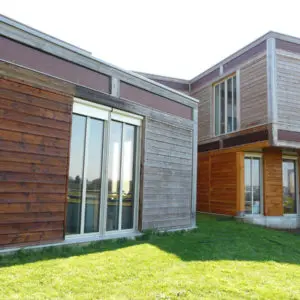Before embarking on finishing your wood cladding, it’s important to make sure that any old coatings are fully removed. If your wood cladding has not been finished with anything before then you can skip this step. However, if it has, you’ll need to remove it. Follow our simple guide to find out how to strip wood cladding.
Stripping off paint or oil from your wood before applying your choice of finish, you can achieve a much longer lasting finish. If you don’t strip your cladding beforehand, you run the risk of your new coating not penetrating or flaking off.
Wood cladding strippers essentially prepare your wood cladding for its new coating, improving both adhesion and penetration.
What kind of product you need to strip your wood, depends on whether you are trying to strip off oil, paint or other types of coatings.
Perform a ‘touch test’
Regardless of which type of stripper you’re using, prior to stripping your entire cladding, you should initially perform a ‘touch test’. In order to do this, you simply need to apply your stripper to a small area of your cladding and leave it. After a short period of time, try to scrub the edge to see if the coating is coming off. If it’s not, leave it a little longer and try again.
Record how long it took for the coating to lift off and then this is your ‘touch time’. As long as your surface is coated fairly evenly, you’ll know how long you’ll need to leave the remover on when you’re stripping the rest of your cladding.
A sample pot of stripper is a great way to do this. If you’re not sure what coating is on your cladding, a sample pot of Dilunett is a great place to start.
How to strip oils from wood cladding
If your cladding is covered in wood oil, we recommend using Aquanett to remove them. An exception to this is if your wood is already treated with an Owatrol penetrating wood oil. If this is the case then you’re essentially performing maintenance and so won’t need to strip and start again. If you’re working with a different previous wood oil though then it will need to go to allow any new finish to penetrate. This solvent-free wood oil remover not only restores the natural colour of the wood but also removes previously applied oil, including teak oil.
The gel-like consistency of Aquanett makes it a great choice for wood cladding, as it won’t ‘run away’ down vertical surfaces.
Using Aquanett is simple: just apply it to your cladding, leave it to work for a maximum of 5 minutes and then scrub your cladding with a stiff nylon brush, whilst rinsing it with water (the higher the pressure of the water, the better).
How to strip paints and opaque finishes from wood cladding
For paint-covered wood cladding, we’d recommend Dilunett.
Its gel-like consistency makes it great for vertical surfaces and it can strip up to 8 coats of paint in only 1 application. As it doesn’t dry, you can leave it on your cladding for up to 12 hours. Dilunett also removes varnish, waxes and most antifouling paint.
Simply apply Dilunett to your wood cladding, leave it to work and then rinse it off with water. While rinsing, be sure to scrub the wood in the direction of the grain.
Always neutralise your wood cladding
After stripping your cladding, you should apply Net-Trol. This will help to prevent the stripper remaining active in your wood cladding and is essential before applying your finish.
Please read all instructions on the product you’re using and ensure that you carry out any safety recommendations.
We hope that you found this article useful. In the next part of our guide, we’ll talk about how to clean untreated wood cladding and restore its colour.
We hope you found this post on how to strip wood cladding helpful. If you have any other advice or top tips, please feel free to leave them in the comments below. We love hearing from you!
You can also follow us on Twitter, Facebook, Instagram or Pinterest at @OwatrolUK or find us under the hashtag #OwatrolUK










hi. what do u recommend for removing anthracite oil based paint from my english oak cladding(200m +25mm overlaps).. i can send u pics if u like?
Hi there Liam,
Thank you for your query.
For removal of an oil based paint from wood we would usually recommend Dilunett: https://www.owatroldirect.co.uk/product/dilunett-gel/ however, Dilunett can react with or darken the tannins in Oak and cause long-term or even permanent issues, so we would recommend using Dilunett only for the absolute minimum time possible, certainly no longer than 5 minutes.
If this is something you would like to try, we would recommend purchasing samples of both Dilunett and Net-Trol: https://www.owatroldirect.co.uk/product/net-trol/ (a neutraliser that must be applied directly after stripping with Dilunett) to test for working times and suitability.
The other option is DSP 800: https://www.owatroldirect.co.uk/product/dsp-800-multi-purpose-stripper/ however, you would likely need to use a lot of the product to achieve the desired results.
As this is a bit of a complicated question to answer, we would be more than happy to discuss this in further detail with you directly before hand.
Please feel free to call us on: 01582 592707 or email us at: sales@owatroluk.com so we can give you the most accurate advice possible.
All the best,
The Owatrol Team
Hi Owatrol Team. This looks great – would this procedure work for softwood treated with linseed oil? The idea is to remove that oil coating and then re-coat with something like Sikkens HLS for UV protection.
Hi there Jon,
Yes, this would work for softwood treated with linseed oil too:
Apply Aquanett to dry wood for a maximum of 10 minutes, then rinse thoroughly. While wood is still wet, apply Net-trol and leave for 20 minutes to work, then scrub and rinse.
Further information on these products can be found here:
Aquanett: https://www.owatroldirect.co.uk/product/aquanett/
Net-Trol: https://www.owatroldirect.co.uk/product/net-trol/
I hope this was helpful.
Please feel free to call us directly on: 01582 592707 or email us at: sales@owatroluk.com for any further assistance.
All the best,
The Owatrol Team